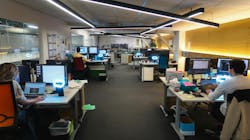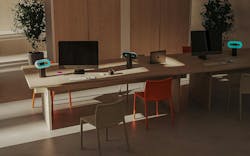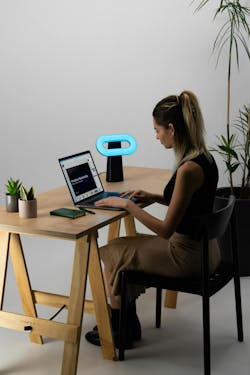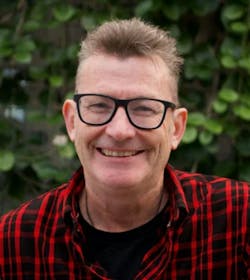LAST WORD | Osin founder pursues circadian accessibility for all
Ralph Booth, founder of New Zealand-based circadian lighting product developer Osin, reached out to LEDs Magazine after reading our early 2023 article “Surveyed scientists stand behind current research for practical circadian lighting application.” The report covered a survey of circadian lighting researchers, led by scientist Dr. Martin Moore-Ede and colleagues to determine the commercial readiness of circadian lighting findings. Later in the spring, Moore-Ede released a book called The Light Doctor, in which he cited some of Booth’s background and drive for launching Osin and its Loop personal circadian lamp.
Short for “outside in,” Osin was founded to deliver “the right light at the right time” in an accessible and user-friendly way, Booth explained. In an interview with LEDs editor-in-chief Carrie Meadows, Booth described what compelled the startup, the development of the Loop, and how the company’s evolving business model overcomes common economic and implementation challenges to circadian lighting.
LEDs: Tell us a bit about Osin — why you started the company and what your mission is.
Booth: I’ve worked in commercial lighting for 25 years. I ran a lighting specification business, experiencing firsthand the barriers to getting circadian lighting into projects. I believe that if we’re going to get traction in circadian lighting, change has to start from within the industry.
About 15 years ago, I became aware of the impact light was having on nonvisual perception and our physiology. It intrigued me — I started learning more at LightFair and other seminars. At the time, we were distributing for Fagerhult out of Sweden and they offered one of the first circadian-tuned light fittings. I was excited about it; I spoke to customers and we got a project specified, but it was very challenging. You’re asking the client to consider something that adds greater energy consumption, complexity, and in the beginning they didn’t understand what we were trying to sell them. In most cases, circadian lighting wouldn’t even get across the line into specification because of the cost and lack of layperson-friendly information available that would get them to understand the purpose.
Meanwhile, my partner was diagnosed and went through extensive treatment for leukemia several years back. You spend so much time in hospital. It wasn’t a good lighting experience for a patient. She wasn’t getting the circadian entrainment support, which is so important to healing when your body is going through something so serious. I even gave her a single blue-light lamp in hopes that it would make a difference.
Later on, our firm was working on a new hospital plan, including isolation wards for a bone marrow unit, and I naively thought that we’d be able to design in special tuned lighting to help those patients. But when the hospital went into the tender stage, all the spectrally tuned lighting was pulled out and it just became 4000K dimmable.
That was so frustrating. I had a lightbulb moment in a bar with a couple of my key people: We’ve got to stop focusing on projects. What we need to do is focus on people. We know the proper spectrum for daytime circadian entrainment is about how the color of a blue sky appears to the human eye. And we have more information on specific wavelengths, timing, and intensity now. What if we could put a small piece of the blue sky on everyone’s desk, where there was a need?
LEDs: What made the individual task area a focus for product development?
Booth: If you’ve got good daylight integration coming into an office, you don’t need to implement a spectral product everywhere. But we’ve surveyed [buildings] and know that many people are working in substandard circadian lighting environments — for example, lower- or mid-level workers who don’t have offices with windows, or those who work in basement settings, like building maintenance, facilities people, and so on. Forty percent of office workers are in need of circadian intervention, without ready access to natural light. And though we have standards for visual acuity and light levels on the work plane, we don’t have those set across the board as a requirement for nonvisual health. The design [is mainly] about the amount of light we place horizontally on the desk — about 500 lux or less than 50 foot-candles, roughly.
If you’re, say, 12 feet away from the window, you are getting barely any circadian-effective daylight. We need to measure circadian metrics and incorporate the lighting thoughtfully. Now we know roughly you’ll end up with 80–100 Equivalent Melanopic Lux (EML) from conventional 4000K or 3500K-CCT LED lighting at 500 lux on the desk. But the current recommendation from WELL Building is to provide 275 EML during a significant portion of the day. And it doesn’t really matter if you refer to EML, m-EDI [Melanopic Equivalent Daylight Illuminance], or CS [Circadian Stimulus], because as far as I can tell they’re all valid metrics. If someone’s talking about them, they’re focusing on circadian health and that matters.
Engineers are just doing floorplans and horizontal lux across the grid on that floorplan. They might do a UGR calculation to make sure it’s not too glary. So our best bet to make an impact where it is needed is not to suggest a full rip-out and retrofit project. That’s where cost, complexity, and disruption make potential customers balk. You can imagine the response — “We just put in all these new LED lights and now you want us to replace them again across the entire building with more expensive ones?”
LEDs: Tell us more about the Osin Loop. What outcomes did you design to and how did you evaluate the claims?
Booth: As we discussed, facilities engineers or building designers can make up a lighting plan. You can measure the light levels and calculate the circadian impact based on the metrics I talked about. Then you mark up the red areas on the plan where circadian light is lacking and put an Osin lamp only in those places.
The Loop doesn’t deliver visual light; it’s not a “task lamp.” It delivers that peak 480-nm blue light, the blue-sky light which is safe and effective to align your circadian rhythm when provided at the right time. Placed no more than two and a half feet away from the occupant, it delivers 268 EML on its own [>250 m-EDI during daytime, and <10 m-EDI in the evening]. It meets recommendations for optimal health based on scientific findings. We’ve referenced a well-known paper from PLoS in our work [Brown and Brainard et al.]. And it’s only 1,788 candelas per meter squared. So it only consumes 4W of energy.
On testing it: We had third-party circadian testing done on the Loop by UL Solutions. We have the test results and we can share those [see nearby table].
LEDs: How was the Loop received commercially? What prompted you to launch the subscription model, and can you explain how that works?
Booth: We launched in Australia a little over a year ago. We then began selling to the U.S. after unveiling Loop at LightFair in New York in May 2023. It was well received by those who were willing to purchase upfront initially. One sleep coach told us she found it so helpful, she started recommending it to her clients [for circadian entrainment].
This was revealing: Older demographics, from 30s to 40s, who were interested tended to buy it and were fine with the US$349 price at the start. But we looked at cart abandonment and found that the younger 20s and 30s demos were engaged in the subject as potential users but weren’t comfortable with the upfront cost. After lots of discussion, we decided to launch a subscription model this year.
It’s the same model as hardware for subscription. They can take an annual subscription at $15 per month or a month-to-month at $19 per month, also in U.S. dollars. Subscribers provide some initial account information. We offer 30 days’ free trial before they get charged to make sure everything works and they’re happy with it.
It’s more accessible to a greater number of people this way. We also have a great story with this now for commercial buyers. There’s a business subscription, much the same rates, but we can negotiate for a number of units to break it down for the financial decision makers in the commercial application. If someone in a corporate setting wanted to purchase 20 units outright, they might have to get budget approval because of the total hard cost upfront. But with a subscription, they can move the cost from capex to opex; it can not only make budgeting easier, they can see the way it works in their offices and cancel if they choose. So they feel there is less risk in spending this way.
LEDs: What about the setup and operation? Does this device account for people in different locales?
Booth: Yes, that’s what really makes a difference, I think, in usability and approachability. It geolocates once you add information to your account for setup. We decided to set the schedule to Equinox Timing — a 12-hour day, 12-hour night all year round because research shows that a longer “artificial” day has benefits in some places during seasonal changes. During summer where you have a longer daylight period, this would be less impactful, but during lower-light months, it has a greater advantage.
At 4:30 PM local time each day, the Loop starts a two-hour transition to “evening light” with an artificial sunset. It gradually shifts to a warm amber light, which UL also measured. In the evening, it’s going back to the recommended <10 m-EDI three hours before bedtime. When it transitions to evening, even on full brightness, it’s only 8 m-EDI. You can even put a Loop in your bedroom at home and dim it down 5% [with the app] and you’ll get less than 1 m-EDI.
It's very simple to operate — one function via an app and it’s the dimmer for nighttime. For now, we’ve decided not to give users functionality access during the day because we want to ensure the user is getting a certified dose of light at the proper times, not a high circadian spectrum in the evening.
LEDs: I imagine this must overcome some of that intimidation people might perceive regarding the complexity, not to mention keeping the technology from being operated improperly like you might find with accessible room-level overrides and controls.
Booth: Yes, exactly! Again, we’re looking at several benefits in the commercial space. One, it’s not a fixed commitment like retrofitting a building. Two, it’s not a big energy burden. Three, it’s cost effective. Four, it’s approachable and updateable via software. And the most obvious is of course that we did our research and have a chronologist and biologist on staff to make this product a reality.
LEDs: What’s the five-year plan? Are you open to investment?
Booth: We’re self-funded; we’re fortunate that we’re in a position with our traditional lighting businesses that we can keep funding for some time. If someone was bringing other distribution and marketing ideas to the table, I’m open to that discussion and possible investment. But any new partner would have to bring those ideas and passion for driving change. That’s my main goal — to engage people in talking about this product, make them aware of what it can do for them, and see more adoption that will demonstrate we’ve made change in this market.
This interview has been condensed and edited for clarity.
CARRIE MEADOWS is editor-in-chief of LEDs Magazine, with 20-plus years’ experience in business-to-business publishing across technology markets including solid-state technology manufacturing, fiberoptic communications, machine vision, lasers and photonics, and LEDs and lighting.
Follow our LinkedIn page for our latest news updates, contributed articles, and commentary, and our Facebook page for events announcements and more. You can also find us on the X platform.

Carrie Meadows | Editor-in-Chief, LEDs Magazine
Carrie Meadows has more than 20 years of experience in the publishing and media industry. She worked with the PennWell Technology Group for more than 17 years, having been part of the editorial staff at Solid State Technology, Microlithography World, Lightwave, Portable Design, CleanRooms, Laser Focus World, and Vision Systems Design before the group was acquired by current parent company Endeavor Business Media.
Meadows has received finalist recognition for LEDs Magazine in the FOLIO Eddie Awards, and has volunteered as a judge on several B2B editorial awards committees. She received a BA in English literature from Saint Anselm College, and earned thesis honors in the college's Geisel Library. Without the patience to sit down and write a book of her own, she has gladly undertaken the role of editor for the writings of friends and family.
Meadows enjoys living in the beautiful but sometimes unpredictable four seasons of the New England region, volunteering with an animal shelter, reading (of course), and walking with friends and extended "dog family" in her spare time.









![The DesignLights Consortium continues to make progress in shifting outdoor lighting products and implementation practices toward a more restrained and thoughtful strategy. [Image does not represent a DLC qualified fixture.] The DesignLights Consortium continues to make progress in shifting outdoor lighting products and implementation practices toward a more restrained and thoughtful strategy. [Image does not represent a DLC qualified fixture.]](https://img.ledsmagazine.com/files/base/ebm/leds/image/2024/08/66be810888ae93f656446f61-dreamstime_m_265700653.png?auto=format,compress&fit=&q=45&h=139&height=139&w=250&width=250)
